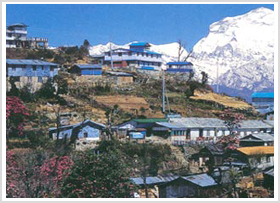
The Bouddhanath Stupa is one of Nepal's most holy sites for the Buddhist faith. This remarkable structure, by far the largest of its kind in the nation, stands as a giant version of the smaller monuments lining the trails in the mountainous lands of the Sherpa people. No one is certain of the historical origin of the great structure, but it has been converging point for worshiping Buddhists in the region for centuries. It constructed as a monument to the Buddha, with a representation of his "all-seeing eyes" painted on the upper tower to watch the four cardinal compass directions. This tower, capped with a great pyramid, all sits atop a great dome and a base of 3 layers. The whole structure has a diameter of approximately 100 meters and a height in the range of 40 meters, which is immense in person. Prayer flag are draped from the top of the monument and fly in the breeze that clears the rooftops of the congested urban neighborhood. The site is located a few miles from the city center of Kathmandu, but this outlying section is still bustling with traffic and the din of street merchants. Tourists and faithful monks alike appreciate the hallowed ground that is a respite from the hectic city.
Tourists are charged a modest fee to enter the front gate and to join the clockwise procession at the base of the stupa. Like air rushing into a vacuum this walkway is filled with more souvenir vendors and begging children. As you walk along you will be hounded by packs of destitute girls and boys, and in the enclosed area there's no way to break free of them. Otherwise the lane is filled with faithful Buddhists spinning prayer wheels as they pass, and there are often Tibetan monks dressed in red who pray and perform their musical talents. The stupa is a brilliant centerpiece for seasonal festivals when it is lined with lamps and there are special parades and ceremonies. The Bouddhanath was built with great structural integrity, which saved it in the earthquake of 1934. It is now maintained as UNESCO world heritage property.
|
